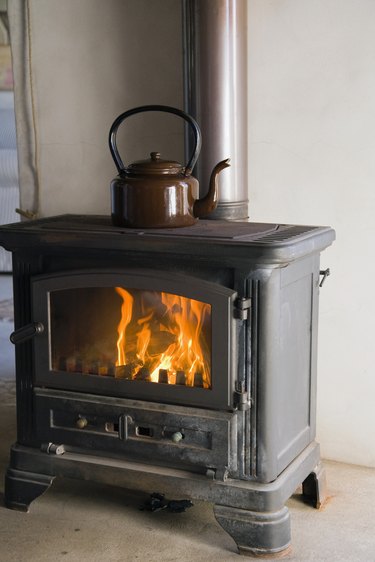
A glowing wood-stove pipe means that emissions stuck to the inside of the pipe are on fire. If not dealt with promptly, this could result in a more serious situation causing significant damage to the pipe itself, as well as to the chimney it's connected to and the surrounding roof.
Chimney Fires
Video of the Day
A chimney fire can manifest itself as a loud roar in the stovepipe, loud cracking and popping noises, a strong acrid burning odor, black smoke coming from the stove itself, and a section, or all, of the stovepipe glowing bright red. On the outside, flames are often seen coming from the chimney, and these pose the most serious threat to the building. A chimney fire can also explode from the stove or the stovepipe into the room it's located in, causing serious damage and injury.
Video of the Day
Creosote
Most fires are caused by a substance called creosote that accumulates over time on the insides of the stovepipe and the chimney flue. Creosote forms when tiny hot ash particles collide with cooler air, resulting in condensation. The particles get caught on the inside walls of the stovepipe and slowly accumulate. The glowing red spot on the stovepipe indicates a thick deposit of creosote.
In some instances, rainwater causes creosote deposits to leak out between the stove pipe seams or to run down the sides of a chimney. If not cleaned out regularly, creosote may go from the soft stage to a rock hard brittle mass in just one season. Small amounts of creosote may burn without much consequence and exit the chimney. The thicker the deposits, however, the greater the potential for a serious stovepipe fire.
What to Do
If you see a glowing red area on your wood-stove pipe, immediately close the stove door and close all draft vents and dampers. On a cook stove, be sure all the burners are in place, and close all dampers and air controls. If possible, throw a chimney fire extinguisher, such as Chimfex, onto the fire, and close the firebox door. If this isn't possible, get everyone, including pets, out of the house immediately and call 911. Once you are outside, hose the roof down with water, but do not spray the chimney with water.
Prevention
A smoldering fire is the primary cause of excessive creosote buildup in stovepipes. During a strong fire, air moves through the system quickly, bringing smoke with it. Smoke that lingers too long in the stovepipe or chimney is a major cause of creosote formation, as is burning green wood or wood that wasn't properly seasoned. Dismantle your stovepipe and clean it out at least once during the burning season, and have the entire system cleaned by a professional chimney sweep once a year. Never burn trash, as the intense flame can quickly ignite creosote, and keep in mind that a small, hot fire is always preferable to allowing a big, slow one to smolder.